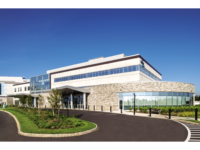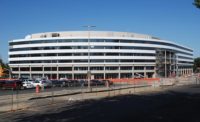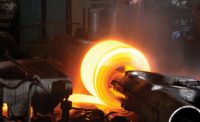As a building owner, the last thing you want is for your façade to fail. Especially when that involves stones falling from your structure to the pavement below. That is exactly what happened with the 500 Pacific Avenue Building in Bremerton, Wash., which required immediate action to protect occupants and passersby.
Constructed in 1965, the façade of the 75-foot tall structure used concrete panels with embedded granite stones. Fast forward fifty years and this Class A office building faced substantial weathering and water damage, which led to mold growth, corrosion of the balconies and the failure of the decorative exterior. In the summer of 2015, the situation became critical when a baseball-sized rock fell from the building to the sidewalk, nearly striking a pedestrian. The building owner, Cardinal Equities, contacted Applied Restoration Inc. to find the source of the issue and determine a solution.
ARI took on this daunting task and installed protective scaffolding and sidewalk canopies to protect passersby until a long-term remediation plan could be identified. They scoured the entire building and removed any rocks that were at risk for delaminating and brushed epoxy into cracks for stability. Upon further investigation, they determined that a full exterior restoration was needed.
Restoration Begins
The project began in February 2018 and encompassed the removal and replacement of the windows and deck railings, significant concrete repairs, the over cladding with EIFS and a new waterproof deck coating. The success of the restoration was a joint effort of ARI, Devco Engineering and the architectural firm, combined with the building material manufacturers, three RPM-owned companies, Dryvit, Euclid Chemical and Tremco Commercial Sealants and Waterproofing. They brought together industry expertise, durable products, training and on-site support.
Keith Simchuk, chief marketing officer for Applied Restorations, explains, “We could find similar options from multiple manufacturers but we kept on going right back to those family of brands because they were able to provide everything.”
For the deteriorating concrete, ARI’s crew used Euclid Chemical’s EucoRepair V100 trowel-applied repair mortar, which was ideal for the vertical and overhead spall repairs. With low permeability, it also protects the rebar from further corrosion. Since ARI had not used the product before, the Euclid team conducted training in the field, enabling the structural and non-structural repairs to be handled with ease.
Technology and Systems Applied
For the balcony surface, a traditional urethane coating was specified to waterproof all the units. But after ARI was trained on the uses and benefits of Tremco’s polyurethane methacrylate (PUMA) system offerings for a different project, they switched this job to Tremco’s Vulkem EWS Pedestrian Coating System with PUMA technology. The long-lasting and flexible waterproofing membrane has a quick turn-around no matter the outside temperature, which was critical because the glass doors leading to the balconies had to be completely removed during the process, leaving the unit exposed to the elements. With each layer of the Vulkem EWS curing in under an hour, the application could be done in under a day, minimizing disruption and discomfort for the tenants.
After the exterior walls were pressure-washed, the areas without stones were coated with Dryvit’s HDP Water-Repellent Coating. This acrylic hydrophobic paint gave the exterior a clean look overnight. The stone cladding sections were then coated with Dryvit’s liquid-applied air and weather barrier, Backstop NT, to stabilize the system and prevent future moisture infiltration. This signature light blue product dries quickly and can be exposed for 180 days, which gave the applicators adequate time before they had to install the exterior cladding.
To replace the outdated stone, various options were considered, including the complete removal of all the stones and a proposal for a metal panel system, which came in significantly over budget. ARI then recommended the prefabricated Fedderlite system, which turned out to be the perfect solution for the job. It would allow the existing cladding to remain in place and provide the look and feel they were after at a fraction of the cost. A mockup panel was sent to the owner so they could approve the color and texture before mass-production. The panels were manufactured in a factory by Lido Wall Systems and included the EPS continuous insulation, reinforced base coat and desired finish coat so when they arrived on site, they were ready to be anchored into the structural cladding.
No Room for Mistakes
While panelization of the EIFS and drainage expedited the restoration and reduced jobsite waste, it gave little room for error. Architects and engineers had to be precise about the design, size, and number of panels to ensure a perfect fit. If the measurements of the 528 delivered panels were even 1/4 inch off, the corners would not align, and the caulk joints could not be applied correctly.
To mitigate this potential puzzle, ARI created a wireframe grid system across the building. This steel frame was anchored into the structural concrete behind the stones to keep everything in place. One of the biggest benefits was the ability to use swing stages to install each lightweight panel rather than scaffolding, which was less labor-intensive and alleviated interruption to the pedestrians in this busy Bremerton neighborhood. “We didn’t have to close down any streets ... if we had to field-apply all this, scaffolding would be a must,” said Simchuk. “Every panel fit like a glove.”
The joints were finished with backer rod and Tremco’s Spectrem 1 Silicone Sealant, which can handle the most demanding dynamically moving joints. Four colors of the sealant were used across the building: bronze, anodized aluminum, gray and a custom shade of orange. The manufacturer also came to the project to conduct silicone adhesion testing to verify compatibility and proper application. The field adhesion test is a hand pull test of a cut area of joint sealant; by analyzing the type of failure that occurs upon full extension of the sealant, cohesive or adhesive, one can determine the success of the bonding of the materials. The silicone sealant exhibited excellent compatibility with and adhesion to the substrates.
A Job Well Done
The entire restoration was completed successfully in 10 months and ultimately stabilized and waterproofed the façade and balconies, making the building safer and watertight. The new windows, air barrier system and exterior continuous insulation provided greater energy-efficiency as well. In the process, these components completely updated the aesthetic.
Utilizing the three RPM companies, Euclid Chemical, Dryvit and Tremco Commercial Sealants and Waterproofing, added peace of mind for the owner and contractor regarding compatibility, testing and results. The President and CEO of ARI, Larry White, cited the comprehensive single-source warranty as a huge convenience that would have been impossible with any other conglomeration of manufacturers.
In their application for 2019 Project of the Year award by the Northwest Wall and Ceiling Bureau, Applied Restoration Inc. described the 500 Pacific Avenue project as “the most dramatic transformation that ARI has completed in the last 20 years!” The building went from an eyesore to a modern gray and orange landmark, earning this collaborative effort the coveted award in the Exterior Renovation Commercial category.









